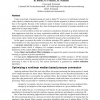Free Online Productivity Tools
i2Speak
i2Symbol
i2OCR
iTex2Img
iWeb2Print
iWeb2Shot
i2Type
iPdf2Split
iPdf2Merge
i2Bopomofo
i2Arabic
i2Style
i2Image
i2PDF
iLatex2Rtf
Sci2ools
FUZZY
1997
Springer
1997
Springer
Optimizing Video Signal Processing Algorithms by Evolution Strategies
Today many kinds of postprocessing are used in digital TV receivers or multimedia terminals for video signals to enhance the picture quality. To achieve this the properties of human visual perception have to be regarded. Because of the nonlinear nature of human visual perception (e.g. perception of edges and objects) many algorithms have been developed and optimized by heuristic methods or by application of rough image models. This is a severe problem as there are sometimes contradictory demands (e.g. detail resolution and alias suppression) and there are many optimization problems which cannot be solved analytically. Furthermore the simulations which have to be carried out in the field of video processing have to take into account a great variety of test sequences and therefore possess a heavy simulation load. In this paper we present the results of evolution strategies (ES) applied to develop and optimize some modules of a video signal processing feature box. The modules we have ana...
| Added | 07 Aug 2010 |
| Updated | 07 Aug 2010 |
| Type | Conference |
| Year | 1997 |
| Where | FUZZY |
| Authors | H. Blume, O. Franzen, M. Schmidt |
Comments (0)

